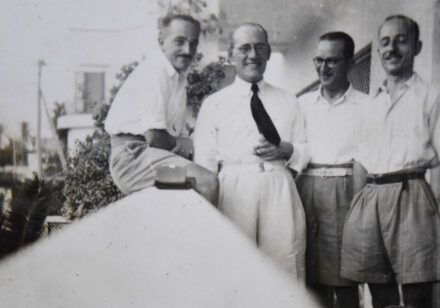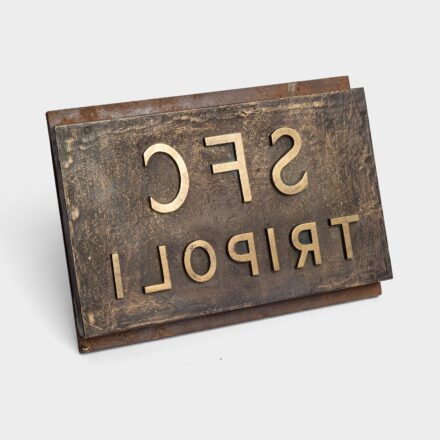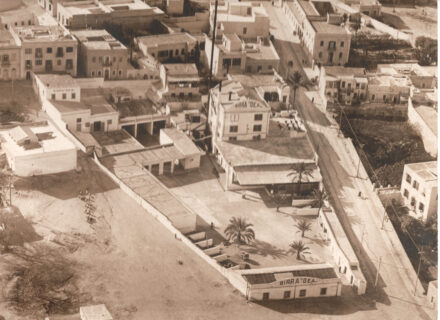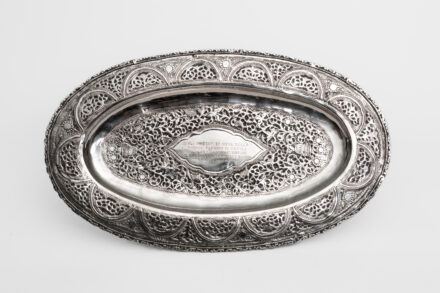
Lewis V. Farrugia (centre left) with George E. Camilleri (centre right) in Tripoli with others involved in the new brewery, 1943. Courtesy of Walter and Patricia Camilleri.
The launch of the Farsons Pale Ale in April 1928 by L. Farrugia & Sons (Farsons) was such an immediate success that within a year competitors H.& G. Simonds of Reading agreed to merge with the Farsons brewery. Simonds-Farsons (S-F) brought together Simonds’ British NAAFI (Navy, Army and Air Force Institutes) network and Farsons’ exclusivity concession from the Crown to brew ales.
Amongst the many British Forces’ outposts, S-F held a two-year lease for bonded stores and bottling operations in the Alexandria (Egypt).
Despite some of the heaviest bombing in the world during WW2, S-F continued beer production and exportation. The British High Command demanded beer at all costs, both for morale and since it was safer to drink than water.

Simonds-Farsons-Cisk (‘SFC’) Tripoli branding iron for wooden crates. On loan from Farsons.
– Photo by Lisa Attard
Meanwhile in Tripoli, Libya, British Forces seized an Italian Brewery called the S.A. Birra OEA on 19 September 1943. The following day, they assessed the holdings in consultation with S-F representative Lewis V. Farrugia and proceeded to assign S-F to run the captured brewery. Our archives show that Farrugia was also commissioned by the British Military Administration (BMA) to assess other captured breweries in Benghazi, Tunis and Messina. Of all these, Tripoli was the desired North African foothold.

Aerial shot of the OEA brewery. Courtesy of Farsons.
As Farrugia was already managing the Malta brewery, he turned to trusted friend George E. Camilleri, a leading insurance businessman, for assistance in managing the Tripoli brewery. In a personal letter to Camilleri’s wife on 12 September 1943, Farrugia addressed her apparent opposition to her husband’s move to Libya;
‘I badly need the services of George in connection with the taking over of the administration of the local brewery. …You may say “why pick on George”. My reply is “for the same reason that you picked on him”. He is the only person who I have known for a long time and what is more … who enjoys my full confidence.’
The letter worked; Camilleri joined Farrugia in Tripoli, while a note from S-F’s Edgar Farrugia to the Asst. Governor General’s Office [Malta] requested urgent permission for Anthony W. Zarb to travel to Tripoli. The latter’s role was to be Asst. Manager.
The official contract relinquishing the Tripoli Brewery to S-F’s management was signed 3 months later, on 14 December 1943, by Sig. Manganelli for OEA and by Farrugia for S-F (Ref-08). A letter dated 23 December from The Chamber of Commerce (Malta) wishes Camilleri, in Tripoli, “hearty greetings and best wishes for Xmas and the New Year”, suggesting that Camilleri had to remain Tripoli, with Farrugia kept extremely busy assessing other breweries, running the Maltese operations, working on his biggest project – the Mrieħel Brewery, and also planning his wedding to Virginia Critien.
Camilleri seems to have remained in Tripoli till at least 24 May 1945. The brewery workers presented him a decorated tray, with an engraved message of gratitude for his administration. Records show that eventually Zarb took over the brewery’s management. However, a passport permit reveals that Camilleri visited Tripoli in May of 1946, at which point his profession was listed as ‘Insurance Agent’.

The silver tray given to George E. Camilleri as a parting gift from the employees of Farsons Tripoli Brewery, 1945.
– Photo by Lisa Attard
Following WW2, discussions between Ing. Schubert, of S.A. Birra OEA, and Farrugia in Rome led to a lease agreement (1947). Its terms specified S-F’s continued operations of the brewery, now for a one-off payment of £10,000 Sterling and an annual rent of 5 shillings per hectolitre sold to NAAFI and civilians. Concurrently, S-F also concluded two agreements with the BMA for a tenancy of offices and stores in Benghazi, Cyrenaica.
The situation in Libya became complex in the following years and facts are vague. Correspondence from October 1948 reveals a plan to purchase the OEA Brewery (Ref-18). This never materialised. Later, references in January 1950 are made to the OEA’s termination of operations. From this point onwards, Tripoli and Benghazi are only referred to as branches.
In the 1960s, as strong anti-Western sentiments swept through Libya, the local government pressured the U.S. and Britain to close their military bases. Huge riots during the 1967 Arab-Israeli War led to attacks on Western interests and even embassies. A SFC Board decision in November 1967 liquidated both the Tripoli and Benghazi branches. Managers A.W. Zarb and M. Castillo were transferred to a ‘National Distributors Company’ of the two main towns. The coup de grâce came when King Idris of Libya, already walking a tightrope, was toppled on 1 September 1969 by the country’s military top brass, headed by Muammar al-Qaddafi.
The rest is [also our] history.
References
Farrugia, V. Lewis. Letter to Mrs Camilleri. Private Collection. September 12th, 1943
The Chamber of Commerce. Letter to Mr George E. Camilleri. Chamber of Commerce correspondences. December 23rd, 1943
Passport Application. Anthony Walter Zarb. National Archives of Malta. 1944-MFA01-29010
Passport Application. George Camilleri. National Archives of Malta. 1946-MFA01-30689
All other dates, facts and historical instances are extracted from SFC Archives.